CLINICAL TRIALS IN DERMATOLOGY – PART I
Abstract
The increasing number of clinical trials in dermatology requires from the dermatologist the ability to evaluate the quality, understand, and synthesize information from multiple sources in order to make decisions regarding the therapeutic/diagnostic strategies. This medical education article explains basic principles, relevant and adapted to the dermatology area, fundamental to an appropriate interpretation of outcomes of clinical trials. Part I of this article looks at the different study designs and their impact on results.
Downloads
References
Alosh M, Fritsch K, Soukup M, Wilkin J. Clinical trials and statistical analyses: what should dermatologists
look for in a report? Dermatol Therap. 2009;22(3):199-203.
Clancy MJ. Overview of research designs. Emerg Med J. 2002;19(6):546-9.
Lachin JM. Introduction to sample size determination and power analysis for clinical trials. Control Clin Trials. 1981;2(2):93-113.
Schulz KF, Grimes DA. Sample size calculations in randomised trials: mandatory and mystical. Lancet. 2005;365(9467):1348-53.
Gottlieb AB, Ford RO, Spellman MC. The efficacy and tolerability of clobetasol propionate foam 0.05% in the treatment of mild to moderate plaque-type psoriasis of nonscalp regions. J Cutaneous Med Surg. 2003;7(3):185-92.
Armitage P. The role of randomization in clinical trials. Stat Med. 1982;1(4):345-52.
Chuang TY, Heinrich LA, Schultz MD, Reizner GT, Kumm RC, Cripps DJ. PUVA and skin cancer. A
historical cohort study on 492 patients. J Am Acad Dermatol. 1992;26(2 Pt 1):173-7.
Chia CY, Lane W, Chibnall J, Allen A, Siegfried E. Isotretinoin therapy and mood changes in adolescents with moderate to severe acne: a cohort study. Arch Dermatol. 2005;141(5):557-60.
Chen SL, Yan J, Wang FS. Two topical calcineurin inhibitors for the treatment of atopic dermatitis in
pediatric patients: a meta-analysis of randomized clinical trials. J Dermatol Treatt. 2010;21(3):144-56.
Remitz A, Reitamo S. Long-term safety of tacrolimus ointment in atopic dermatitis. Expert Opin Drug
Saf. 2009;8(4):501-6.
All articles in this journal are Open Access under the Creative Commons Attribution-NonCommercial 4.0 International License (CC BY-NC 4.0).








